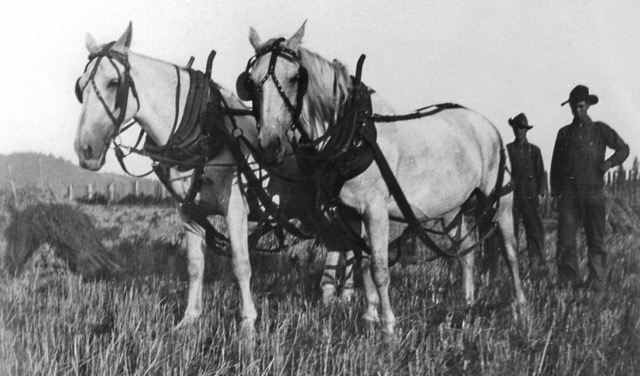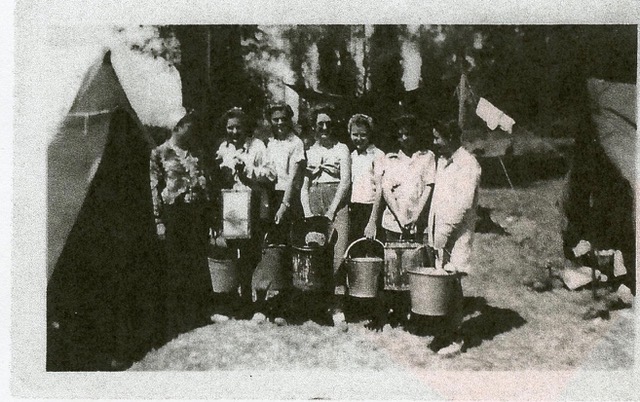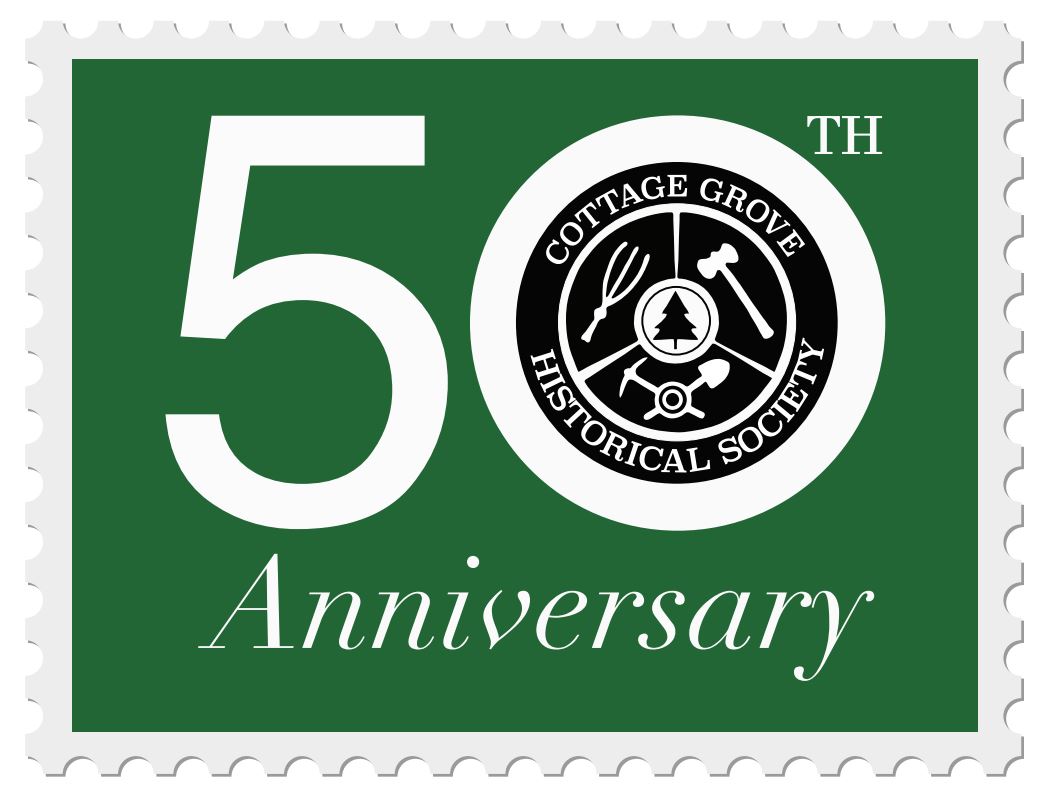By Katy Vaughn
The earliest settlers in Cottage Grove farmed their lands. Most of what they practiced was subsistence farming, growing enough for their own use, with a bit left over for market. The timber on their property was considered a nuisance once the house, barns and fences were built. What they wanted were nice cleared fields for crops and stock. According to an early account by Marguerite Overholser of settler David Mosby: “As all settlers made their living from the land, so did he. His cash money for supplies came from hogs. He would butcher as high as sixty a year. At butchering time, the meat was packed in salt in a salt box made by hewing out the center of a 30 inch log twelve feet in length. After a few days in the salt, the ham, shoulders and side bacon were hung from poles, wall to wall, in the smokehouse. A slow fire of vine maple was kept smoldering and smoking, thus curing the meat. The hams and bacon were then hauled to Portland by team and wagon, a tiring trip, one week going and one week coming back with supplies.”
The two busiest times of year for the early farmers were haying and threshing. Haying happened in early July using horse power to mow and rake the hay. Threshing occurred in late August or early September and involved the whole neighborhood. If a farmer did not own or borrow a thresher, he hired one from the McDole brothers of Latham. A threshing crew generally consisted of about 15 men and the farmer’s wife was expected to feed them all.
 The first commercial agricultural processor in Cottage Grove was the flour mill, built in 1857. Its waterpower came from the mill-race which ran from a wooden dam on the Coast Fork River from near the site of the Chambers Railroad Bridge on down to the mill site on Silk Creek. Many farmers would bring wagon loads of sacked wheat to the mill in exchange for flour for the winter. Some of the flour was used to supply the Bohemia mines. The mill could make 48 barrels of flour per day and had storage space for 5,000 bushels of wheat. The brand name was Pride of Oregon. The mill stopped producing flour sometime in the 1920’s and became a feed and grain cleaning operation. In 1949 the old mill burned down. The location is now the site of the Old Mill Farm Store.
The first commercial agricultural processor in Cottage Grove was the flour mill, built in 1857. Its waterpower came from the mill-race which ran from a wooden dam on the Coast Fork River from near the site of the Chambers Railroad Bridge on down to the mill site on Silk Creek. Many farmers would bring wagon loads of sacked wheat to the mill in exchange for flour for the winter. Some of the flour was used to supply the Bohemia mines. The mill could make 48 barrels of flour per day and had storage space for 5,000 bushels of wheat. The brand name was Pride of Oregon. The mill stopped producing flour sometime in the 1920’s and became a feed and grain cleaning operation. In 1949 the old mill burned down. The location is now the site of the Old Mill Farm Store.
The Doolittle and Bales families had commercial orchards on Rat Creek back in the early days. They shipped their fruit to Portland by rail, and from there to points east, including New York. High shipping costs put these operations out of business. Later fruit growers had better luck when the Cottage Grove Cannery was built.
Construction started on the Cannery building in June of 1908. Stock was sold at $5 per share and farmers were allowed to pay for their shares in fruit. Getting it off the ground was slow going and fruit was not processed there until 1918. That year 185 tons were processed and in 1919 288 tons were processed. Most of what was processed at the cannery were pears and apples from the Lorane Orchards, but many local farmers and housewives sold fruit to be canned for extra money. Almost everyone in town sold berries to the cannery when they were in season and it was a popular way to pay for school clothes. One worker remembered the thrill of using her own money to buy silk stockings as her mother would only buy her the thick cotton ones. The American Can Company provided the cans and the equipment for sealing the cans. After the cans were filled and sealed, they were put into large metal baskets and lowered into vats of boiling water to process. 100 gallons of produce could be processed at one time. In 1919 the cannery was doing well enough to pay dividends to stockholders, but by 1926 it failed to turn a profit and went out of business.
 Over time timber surpassed agriculture as the economic engine of early Cottage Grove. However, small farms kept on producing. Beans were an important crop well into recent times. In the middle of the 20th century about one third of the bean picking work force was high school students. It was not unheard of for farmers to ask that the start of school be delayed if the crop was late getting in. An old photo shows the Rainbow Girls of Cottage Grove saving the crop during World War II when there were not enough workers for the harvest, due to the War effort. Many old-timers in Cottage Grove remember working the bean fields in the 50’s and 60’s to earn money for school clothes much as their grandparents did picking berries for the cannery in the 1920’s.
Over time timber surpassed agriculture as the economic engine of early Cottage Grove. However, small farms kept on producing. Beans were an important crop well into recent times. In the middle of the 20th century about one third of the bean picking work force was high school students. It was not unheard of for farmers to ask that the start of school be delayed if the crop was late getting in. An old photo shows the Rainbow Girls of Cottage Grove saving the crop during World War II when there were not enough workers for the harvest, due to the War effort. Many old-timers in Cottage Grove remember working the bean fields in the 50’s and 60’s to earn money for school clothes much as their grandparents did picking berries for the cannery in the 1920’s.
The 21st century has seen a resurgence of farming as small, organic operations have moved into the area. You can learn more about them and their products at
https://www.facebook.com/CottageGroveFarmersMarket.

